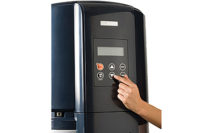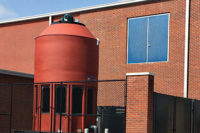The larger the delta T (temperature difference between ambient and the maintain temperature of the system) the more variation the system would experience. While this is usually not a problem for replacement of steam tracing systems, tighter statistical process control parameters predicted better yields and product quality if the temperatures could be held in a tighter range. Exploration of methods for controlling temperatures give a greater insight into the possibilities for tighter temperature control for electrical heat tracing systems.
Previous work determined the following heat loss factors for various valve types. These heat loss factors have been normalized against the heat loss of butterfly valves in the last column of Table 1.
These factors have been used for years and have been adequate for freeze protection systems, but users have reported wide temperature variance at high temperature difference. Also the users have observed increased temperature variation for large and small pipes. This can be accounted for by the fact that heat loss of a pipe increases linearly with pipe diameter and valve heat loss increases with the square of the pipe diameter. Thus, with a constant factor in Table 1, the heat loss of the valve doesn't "keep up" with the heat loss of the pipe. Figure 2 shows the results of a finite element analysis of a butterfly valve.
Insulation is provided only on the body up to the flange on the bonnet. The pipe temperature is kept at 10 degrees C and ambient is -20 degrees C. We can see the bonnet of the valve is well below freezing. This models a bad case, i.e. more heat loss than one would like, but many applications in the field are much worse. The quality of installation and k factor of the thermal insulation on valves is usually poorer than the insulation on the pipes. This leads to lower temperatures on the valves than on the pipes. Most analyses are done using the k factor of the piping insulation, but valve insulation is sometimes different and probably a higher k factor which means more heat loss.
Analysis showed the heat loss through an insulated valve body was an order of magnitude less than the heat loss through the valve stem. For our analysis we assume the insulated valve body is adiabatic and all heat loss is through the valve stem. Even with this assumption, the heat loss is much larger than the values seen in Table 1. Needless to say, a wide variation in heat loss values can give significantly different steady state temperatures when the different assumptions on thermal insulation are used. Figure 3 shows an FEA of an insulated welded pipe support. The same problems occur here in that it is difficult to insulate and there is much variability in installation practices. We see ambient temperature being reached within the insulation because of the long slender cross-section of the pipe support.
There is again significant heat loss and a probable decreased temperature at the support.
The bottom line is that the heat losses for valves, supports and open-ended vents are extremely variable and the actual installation
will not be what is calculated. Given these variable heat losses, what can be said about the temperature distribution in the piping
system and how can an engineer design a system that will have the needed temperature range? There are a number of answers.
Separate circuits and control
Designing with a separate electrical circuit with a separate control can be used but is usually too expensive. Analysis done on complicated piping showed the need for an average circuit length of about 20 feet if all valves, supports and dedicated instruments were to be separately controlled. At between $2,000 and $3,000 per circuit, this expense is prohibitive.Self Regulating Heaters
Self regulating heaters with a high self regulating index provide more help. A load line analysis shows the difference between a constant wattage heater and a self regulating heater. Figure 4 shows a load line analysis for constant wattage and self-regulating heaters. The desired maintain temperature is 50 degrees F and at the minimum ambient of -20 degrees F this pipe temperature is maintained by both systems.As usual, both systems are overpowered, using 5 watt per foot heaters when the heat loss at minimum ambient is about 4 watts per
foot. As ambient increases, the stabilized temperature of the pipe also increases. For the self regulating heater it increases to 110
degrees F and for the constant wattage heater it increases to 190 degrees F. The self-regulating property "manages" the
temperature on a local level. This type of analysis is also useful for process temperature maintenance designs.
Proportional Ambient Sensing Control
An addition to available control schemes is Proportional Ambient Sensing Control (PASC). This control will measure ambient, determine the heat up and cool down rates of the smallest pipe, and cycle the power to the heater circuit depending on these variables. This will impose a duty cycle on the heating system that decreases the variability of the temperature range. One can think of it as global control with a local override by the self-regulating heater.At minimum ambient the power is on 100 percent of the time. As the ambient temperature approaches the maintain temperature, the duty cycle decreases proportionally. If the maintain temperature is above the maximum ambient temperature, the controller never shuts off completely, and there will always be some proportion of the duty cycle maintained.
This system also adjusts heat input for valves and supports, depending on their actual thermal characteristics instead of the design
characteristics. If a valve is a little hot, the self-regulating heater supplies a little less heat, it is cold it supplies a little more heat.
This global system reduces circuit costs since now flow paths are not a critical part of the design. This method has been used with
freeze protection systems with ambient control, and now an improved version is available for process temperature maintenance
systems. Significant cost savings and a tighter temperature control band is available. Figure 5 shows the relationship
between control type and temperature variation for various electrical heat tracing control categories. The variables are numerous
and generalities are not very applicable. However, "Help is on the Way" in the form of expert system (1) design programs to
calculate various expected parameters.
Comparison with steam tracing
If electrical tracing is to replace steam tracing the economics must be favorable. In the past, constraints have been applied to electrical tracing that were not applied to the steam tracing that was replaced. Point controls with separate circuits, costing $3,000 to $5,000 extra per circuit, were specified for the replaced steam circuits. If steam was a viable tracing method, the probability is high the fluid was insensitive to large temperature swings. If the traced fluid could not stand temperature swings, steam would not have been an acceptable solution. Group control, without regard to flow paths, resembles a steam system with supply headers. This paradigm permits a simpler design and construction model for electrical heat tracing systems. Figure 5 doesn't tell the whole story. If cost is considered, the least costly system is the self-regulating heater with PASC control. This emulates a steam tracing system in grouping headers and running circuits off the headers. One must remember, however, there will be a wide temperature range possible for the fluids. If designed and installed correctly, the temperature range will be tighter than most others, but there is also a possibility of wide temperature variations, just like there is with point control spread over different thermal features. If your fluid is temperature sensitive use one of the expert heat tracing design programs to estimate Maximum Uncontrolled Temperature. If this is no problem for the fluid, a group control will be most economical and reliable. There are many fewer parts in a grouped system than a point control system.Electrical heat tracing has become the technical choice for most tight temperature range processes. Temperature variation, because of differences in thermal features, creates the opportunity to have significant temperature variations. Analysis shows these to be a non-trivial problem. New control and monitoring systems, coupled with self-regulating heaters, give the design engineer new options for both satisfactorily tight temperature ranges and economic solutions. Group PASC control eliminates the need for flow determination and reduces the number of circuits. This ability to group the electrical circuits and the availability of cut-to- length heaters permits the design engineering to be delayed until a later stage in the design cycle. This permits "Just In Time" engineering without the usual redesign when the piping changes. We expect the use of group PASC control to increase in the coming years as the engineering community accepts the reality that most fluids can stand a 100 degree F temperature variation and steam is really an expensive way to trace process piping. PASC control will be the system of choice for non-critical process temperature maintenance.
But whatever system is used for control, significant engineering must take place in order to quantify the temperature variations seen
in the piping and instrumentation system.
References
1. TraceCalc Plus (version 4.0) Raychem Corporation, Menlo Park, CA2. Sandberg, C., et al., Secondary Factors in Electrical Heat Tracing Design, 1966 IEEE PCIC Conference, Philadelphia, PA, Sept. 1996
3. Nolte, Don, Raychem Internal Memo, Tracing of instrument lines with main header pipe, October 1995
4. ASAP AutoTrace Steam Analysis Program, Raychem Corporation, 1988
5. HeatCalc, Thermal analysis program for heat up and cool down, Raychem Corporation, 1987

